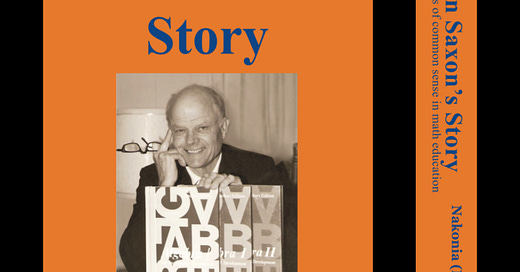Chapter 16: learning the lay of the land
“Of the top 10 states for mathematics scores, not one of them had state adoption.
Of the bottom 13 states, all but one had state adoptions.”
National Assessment for Educational Progress (NAEP), 1992
It was one thing for the elite mathematics establishment to snub him and his Algebra I book in 1981. It was another rude awakening for John to learn his proven book would not be welcomed with open arms by 22 states that chose books by many reasons other than proven results. They had “textbook adoption committees” and the game was purely political. That included slick sales, gifts, and power stances among those in charge, both in publishing houses and in legislative chambers. Taken aback by this new and unfamiliar minefield of politics and what often turned out to be shallow decision-making criteria, John, as an emerging entrepreneur who had learned he had to land on his feet at all times, geared up for a circus act known within those states as their “textbook adoption process.”
Dating back to Reconstruction days, textbook adoptions had been state-controlled mainly in the South and West. The story is that southern states didn’t want their children to read about the Civil War from the perspective of the North, so they demanded textbooks be written specifically for a “southern” adoption.1 Publishers obliged in order to sell their books. During John’s publishing years, those states included Kentucky, West Virginia, Virginia, South Carolina, Tennessee, Georgia, North Carolina, Florida, Alabama, Mississippi, Louisiana, Arkansas, Texas, Oklahoma, Kentucky, Indiana, New Mexico, Arizona, Utah, Idaho, California, and Oregon.
Individuals in favor of the system said that it took time-consuming tasks away from those at the local level. That seemed to be the one reason to support the statewide committee of reviewers who were chosen by unknown criteria. In fact, those reviewers were usually anonymous, which meant their decisions could not be challenged and there was no accountability for their decisions. They were, in general, schoolteachers and school-district officials, with maybe a parent or ordinary citizen added to the group. The reviewers submitted reports or ratings to the official textbook adoption committee members, who then created a collective judgment about the books and made recommendations to the state board of education about which books to adopt. Individual reports were not written so that taxpayers could know who inspected and endorsed any particular book. This protocol rang true to John’s constant criticism about “committees of experts” in mathematics education whose individual members were not be held accountable for their decisions.
Since many of the reviewers of textbooks were educators who worked in the subject area, the assumption was that such professionals had some knowledge of how to “assess” the books put in front of them. Generally, they did not. They had not received training of how to evaluate a textbook—aside from that of publisher representatives who had their own agenda when “explaining” their wares, according to a 1985 article in Educational Leadership magazine.2 In addition, said author Connie Muther, in 1978 only one percent of teacher training institutions provided a textbook evaluation course. For the few courses that existed, those were in graduate schools.
Professors were considered unaware of the change in textbooks, she wrote, but would distribute checklists for students to use and report back to the rest of the class.
Students were not shown where and why textbooks were weak, how they differed, and which program best matched an identified goal. Even for teachers not serving on textbook selection committees, this kind of training would have been important for assessing the textbooks they were assigned to use in their classrooms. Districts did not seem to be aware that there was a problem with this situation. Many felt there are more pressing issues to address, according to Ms. Muther.
She reported that according to unpublished research by publishers, the primary determiners for textbook selection were pretty pictures, heaps of independent seat work, and easy-to-use manuals.3 Also highly influential were personable sales people—those who told jokes, brought doughnuts, and let committees leave the “training” meetings early. Free consumables and free pilot materials were also winners. Getting the “best deal” swayed 20 to 70 percent of district decisions nationwide according to estimates of several publishing executives.
Even when John began selling his first book in 1981, the textbook publishing business was supposedly starting to decline due to audiovisual and computer competition. Timing factors were thus essential for new textbooks, which included the writing (up to three years by committees of authors for K-8 materials), scheduling the printers (required months in advance notice because several publishers used the same printers), and meeting state adoption deadlines that, Ms. Muther said, were “unforgiving.” To miss an adoption deadline meant the publisher could have to wait for about six years before trying to sell his book again to the state’s textbook committee.
Because of this timing problem, completed programs were rarely field-tested, even for the high school textbooks that may have required only 18 months for completion by a single author. (The fact that John had run a field test on his Algebra I book and had published the successful results was therefore a rarity in the textbook industry and should have been a major factor when states were reviewing books.) Sample lessons might be tried out on groups of students to see if directions were clear, lesson format was workable, or how teachers and students reacted to the materials so any changes could be made before the printing was completed.
“That means the buyer becomes the field test for many newly developed programs,” said Ms. Muther.4 Most important was that the product appealed to the buyer, and for elementary schools that meant the pictures must be appealing and the instructional part of the program should not appear too lengthy because that meant it could be too difficult to teach. Appropriate topics must be included at the right grade levels for middle and high schools, especially in Texas, California, Florida, and North Carolina. “Neglecting to mention some of these states’ preferences could mean instant elimination.” This “mentioning” aspect was discussed further as Ms. Muther explained that as long as there was at least a “mention” of a topic, the book could usually pass state requirements.
Supplementary materials were also in demand. Those had to be numerous and provide easy-to-correct independent seatwork. They had to meet the needs of all types of students, from learning or emotionally disabled; visual, speech, or hearing impaired; and those from other cultures or other languages. There had to be options for the gifted and talented and letters offered to parents in other languages. If any of these items were missing, the whole program could be eliminated. Strangely, many supplemental materials that were designed to meet those “special needs” were not written to correlate with either the content or instruction of the subject matter because they had been created by outside editorial service organizations, which, coincidentally, were writing for competitors. One sales agent who heard Ms. Muther talk about this situation at a workshop told her, “It’s true. Many supplementary materials are written by low-paid writers and are not very good. But if we don’t have them, we lose the adoption.”5
She was quick to add that most publishing houses were staffed by knowledgeable, dedicated, and honest employees who were usually former educators and who were often frustrated because they were constantly having to compromise between “what sells and what’s best.” She said, “Today’s publishers do not have the resources to produce a new product that may be superior educationally but has a high risk of failure. To produce an Edsel in today’s market could be catastrophic.” What Ms. Muther did not know in 1985 was that from 1991 to 1999, the National Science Foundation would pump almost $84 million into publishing coffers if they would write programs to support the NCTM Standards. Money would not be a problem for publishers who wanted to climb onto that ideological bandwagon.
Ms. Muther did agree that adoption states and special interest groups had contributed to producing textbooks “designed by a committee, written by a committee, and selected by a committee.” That meant “many textbooks have no clear point of view since there is no one author,” she said. “The result is too many textbooks with too many facts and pages, unrelated to underlying concepts.” Instead of being what Webster defined a textbook to be, she said—“a manual of instruction, as containing the principles of a subject used as basis for instruction”—it had become the total program so that teachers didn’t have to find appropriate topics or activities to support the basics for their particular students.
That meant the publishers’ program became the district’s program. That, she maintained, clearly pointed out the necessity of providing time and training to those evaluating any textbooks for their districts or states. Otherwise, “The selection committees will continue to focus on “pretty pictures, favorite topics, amusing agents, and seducing sales presentations.” The she said, “If districts also continue to focus on free materials, then publishers will continue to compete by providing bigger and better deals.” Of course, this extra material also costs districts extra dollars.
Ms. Muther wrote that with each new adoption cycle, which ranged from five years in some states to seven or eight years in others, textbooks would have to come back with “upgrades” to reflect a state’s new standards or their new testing requirements. Not all new editions were academically stronger textbooks, however, since the new edition may not even contain an upgrade in conceptual materials.6 The publishers may have simply added user conveniences such as lesson reference numbers or changed the cover of the book and order of the content, but actually did not improve the academic content.
In summary, she explained there were three valid reasons why publishers release new editions of their math books.7 First, mandated state or federal standards require them to revise the contents. Second, they have developed new and useful technology that enhances the book’s contents. Third, they have voluntarily strengthened the contents. It is up to the textbook selection committee to determine which of those reasons impacts the books on their list for review.
The Textbook League (TTL) of California went further with its own negative assessment of the overall textbook selection process.8 They made the daring charge that state agencies didn’t want legitimate evaluations of the textbooks “because the agencies are allied with the publishers. The adoption proceedings staged by these agencies are not designed to help school districts, to protect students, or to serve the interests of taxpayers. Rather, they are designed to serve the interests of the publishers.
“Incompetent committees engage in group-grope,” they declared, “as they nonsensically try to average a bunch of guesses.” The league concluded that corrupt proceedings were corrupted further by publishers “presentations” and state agencies’ surreptitiously supporting of textbooks by publishing catalogs that explained the states’ adopted books. The descriptions of the books, said TTL, were actually copied from promotional materials sent by publishers and were therefore nothing more than unpaid advertisements for an unsuspecting public.
While materials from several publishers may make it to the state’s textbook adoption approved list, which meant the state picked up the tab for any books chosen by a district off that list, the proliferation of freebies from publishers did not stop at that door. There was still the need to sway purchases at the district level. “As customer priorities change and it becomes more important that programs worked for kids, the ‘What do I get for free?’ and ‘How many trucks will you back up [to our schools] for the sale?’ won’t be as important,” said a former Houghton Mifflin employee. It really ought to be about what works.”9
A personal tale of textbook adoption committee “methodology” was recorded in a 1964 book by Dr. Richard Feynman, who had agreed to serve on that state’s adoption committee for elementary mathematics textbooks. The chapter detailing with his experience was reprinted in TTL’s newsletter with the following declaration: “The same events that Richard Feynman experienced in 1964 are as pervasive in 1999.”10 It thus provides an accurate backdrop to what John faced when trying to get his proven book into public schools 20 years later.
Called a “premier physicist of the second half of the 20th century, Dr. Feynman had worked on atomic weapons at Los Alamos during World War II and was one of the three men whose contributions to quantum electrodynamics were commemorated by the 1965 Nobel Prize in physics. In his autobiography, Surely You’re Joking, Mr. Feynman, this world-reknown physicist has a chapter called “Judging Books by Their Covers,” which is a tale of humor but terrible frustration of shallowness, stupidity, and shades of corruption as part of the “process” of choosing textbooks for his state’s students.11 He talks in depth about the poor content material and the incompetent “processing” activity itself.
Dr. Feynman reviewed how he received letters and telephone calls immediately from publishers. He told them, “You don’t have to explain [your books to me]. I’m sure the books will speak for themselves.” The state book repository (from where all textbooks are sent to schools, which means they are not sent from the publishers directly, which meant another layer of bureaucracy is established in state government) that he would be receiving copies of all the books being considered—about 300 pounds worth. Expressing some reaction to this, he was told that someone would help him read the material. Dr.Feynman said, “I couldn’t figure out you do that: you either read them or you don’t read them.” He soon realized, as he read what he called “lousy” textbooks, that the authors weren’t smart enough to understand what was meant by rigor. He said he knew what they were trying to do: “The purpose was to enhance mathematics for the children who found it dull.”
Explaining that he never attended the entertainment activities staged by publishers, he admitted he did receive a package of dried fruit one time with a message that said, “Happy Thanksgiving—from our family to yours—the Pamilios.” He tracked them down through Western Union and learned it was from a publisher. He told the man, “This could be misunderstood.” Another publisher sent him a leather briefcase with his name in gold on it. Dr.Feynman called him and said, “I can’t accept it!” A fellow committee member said this kind of thing had gone on for a long time. Dr. Feynman did admit he missed one special opportunity when he was attending a meeting in San Francisco. Two guys were sitting on a bench in the lobby as Dr. Feynman stepped out of the elevator. They offered to take him to eat at a restaurant. He declined. He said he couldn’t resist, however, saying, “I’m going out to get myself in trouble.” One of them said, “We can help you with that, too.” He thought later, “I should have kept all of this kind of stuff in a diary so the people of California could find out how far the publishers will go!”
Then he went to his first committee meeting with its 10 members. Everyone had sent ratings on the books to the repository director but Dr. Feynman’s ratings were lower than the others. They asked him why his ratings were lower and he quoted reasons from pages in the books from his notes. He had a reason for every rating. They wouldn’t explain to him, however, why they had rated the books they way they did.
The group came to a set of three supplementary books from one of the publishers and Dr. Feynman was asked what he thought. He said he had only received two of the books. He was asked again what he thought of the books. He repeated he hadn’t received all three books. The man from the depository explained that the publisher was going to be a few days late with the third book, so he had sent just the book cover with blank pages in it. He did that in order to meet the deadline to have all materials into the depository by a certain date. The publisher hoped his books would still be considered.
Dr. Feynman exclaimed the stunning part was that members of the committee had ranked this book of empty pages! The list from the director showed the “averaged” ratings for that book of empty pages which were, as it turned out, higher than the ratings for the two other books in the set. It seems he was the only member of the committee who had actually looked at all of the books submitted for review.
It also turned out that he was the only one of the committee who had not received help from publishers whose representatives explained the books before the reviewers read them. Dr. Feynman maintained that since all of the teachers wouldn’t have personal explanations about the books, he didn’t think committee members should have all that assistance either.
The following year the textbook committee would review science books. Dr. Feynman looked at a few and said they were horrifying. “They said things that were useless, mixed-up, ambiguous, confusing, and partially incorrect.” So he resigned from the committee. Feeling a bit frustrated when he heard that one particularly bad book was going to be recommended by the textbook committee to the California Board of Education, he decided to be one of the public speakers at their meeting. He told them he thought the book was bad. He said the man who had replaced him on the committee said, “That book was approved by 65 engineers at the Such-and-Such Aircraft Company!” Dr. Feynman thought, “They must have some pretty good engineers there, but to take 65 of them is to take a wide range of ability—and this will include some pretty poor guys!” The book was approved by the board.
John decided to approach the shenanigans around publishers’ competitive efforts from an unexpected vantage point. In 1989 he printed an advertisement with the title, “Don’t Blame the Publishers.”12 He wrote, “The continuing disaster in math education cannot be blamed on the publishers of mathematics textbooks. The publishers cannot be held responsible if their customers demand and purchase inferior products. Companies such as IBM, JRJ-Nabisco, and General Motors are in business to make money for their stockholders. If the managers do not make money for the stockholders, they are fired and replaced with managers who can. It is unrealistic and unfair to ask textbook publishers to be altruistic first and greedy second. They are in business to sell books and to make money just like all the other companies.”
He wrote that publishers could sell books and make money by being sure that their books contained the latest fads recommended by the national leadership in mathematics education. He pointed out, again, that almost none of the fads had been tested extensively and proven to be effective. For example, he said that one major publisher had six pages of “non-standard problems” scattered throughout the pre-algebra book. At the top of each page, a boldface statement appears saying, “There is no simple method that can be used to solve these problems. Do the best you can. Do not expect to find an easy way to get the answers.” He said, “This translates as ‘Math is hard. Math is a tricky subject. Math does not follow rules.’”
In July 1993, in an open letter to then-President Bill Clinton, John complimented the President on the fact that while he was still governor of Arkansas, he had supported a bill in the legislature that returned control of textbook selection to the local school boards. John said that local control was something he felt would keep the “unknowing” at the state level from being able to control the local school boards and administrators and allow them to solve these problems locally.13
A year later, he wrote in another advertisement, “The flies in the ointment are the textbook adoption states. Almost every state that has trouble in education holds an adoption process at the state level to make the taxpayers think the state department of education is ‘doing something’ to turn things around. You can get an idea of the mentality of the adoption states by noting their position on the map. They are Kentucky, West Virginia, North and South Carolina, Georgia, Florida, Alabama, Mississippi, Louisiana, Arkansas, Texas, Oklahoma, and for some unknown reason, Oregon.”14
He often stated that these states also had the lowest performing students in mathematics on standardized tests. In fact, according to the 1992 “nation’s report card,” formally called the National Assessment of Education Progress (NAEP), of the top 10 states for math scores, not one of them had state adoptions. Of the bottom 13 states, all but one had state adoptions.”15













Share this post